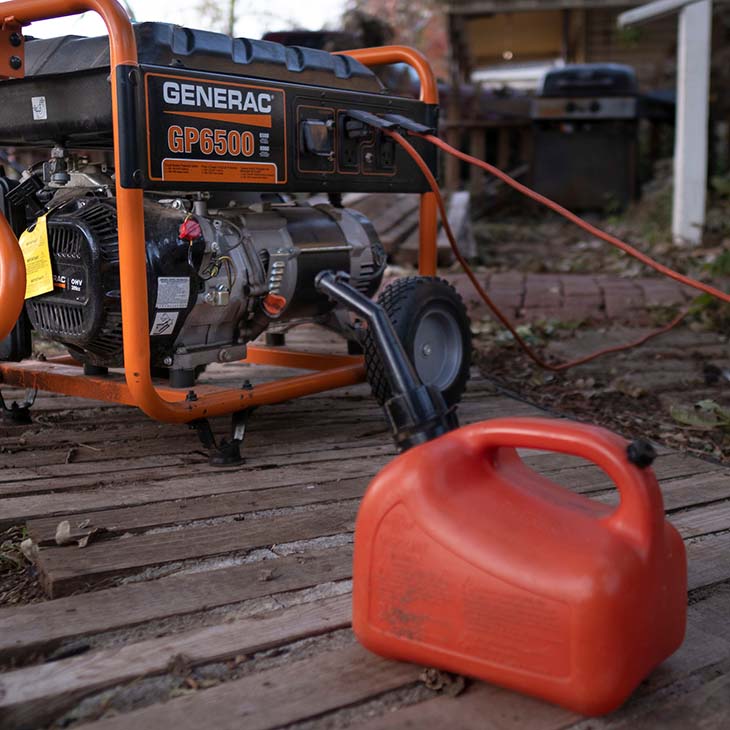
Before the next freeze: buying and safety tips for generators
Friday, November 20, 2020
Oklahoma received a warning of how harsh winter can be during a recent ice storm that left thousands without power. Some residents had utilities restored within a few hours; others were left in the dark for nearly two weeks.
Homeowners who were sweating over freezers and refrigerators full of groceries have good reason to plan ahead and buy a generator before the next freeze, said Gina Peek, interim associate dean and Oklahoma State University Extension housing and consumer specialist. That preparation requires caution, however.
“Before purchasing or using a generator, do so only if you must,” Peek said. “Consider if you have alternatives, and do those first. For example, if another place to stay is available, stay there until power is restored.”
A few simple calculations before heading to the store will reveal why alternatives could be safer. Small uses add up quickly.
“Determine whether you’re needing power just for appliances and lights, or do you also need enough power for computers and home electronics, as well,” said Scott Frazier, associate professor in OSU’s Department of Biosystems and Agricultural Engineering.
Frazier provided some tips and figures:
- Determine power needs. Portable generators can range from 900 watts to 10,000 watts.
- Consider the ease of transporting the generator. Some come with wheels, while others are light enough to carry.
- Look for a generator with at least 10 hours of runtime.
- Determine how many outlets are needed on the generator. This will depend on the number of appliances that need to be powered at the same time.
Next, determine what it takes to start – not simply run – each appliance. Frazier said the starting wattage is the amount of wattage needed to start an appliance with a motor. This may be two or three times the wattage required to simply run it.
Once homeowners have determined what appliances and other things will require power, calculate the total power needs. Add up the running wattage for all items needing power at the same time, then add that total to the highest starting wattage.
“It may be a bit surprising how few appliances a generator can handle,” Frazier said. “High wattage devices like electric heaters can use up most of the capacity of a small generator, so pick the most critical electrical needs carefully.”
All that power is reason for Peek’s concern.
“First and foremost, never use a generator inside your home or the garage, even if the windows and doors are open. The exhaust from a generator contains carbon monoxide, which is poisonous,” she said. “Carbon monoxide is odorless, and you can’t see it, so it can kill you and your family in a matter of minutes.”
Additionally, never wire a generator directly into the home breaker panel without a safety transfer switch. That keeps the generator from back-feeding and electrocuting utility linemen repairing the lines, said Peek. Instead, power the few necessities directly from the generator front panel.
Something else to consider is the gauge of the extension cord, which is directly related to total amperage. Thicker cords can be longer, allowing homeowners to place the generator farther away from the house.
When using a generator:
- Read the label and owner’s manual and follow instructions.
- Use the generator outside, far away from the home.
- Install carbon monoxide detectors outside of sleeping areas in the home.
- Get to fresh air quickly if you start feeling sick, weak or dizzy.
- Never use cheap, thin extension cords as they can overheat and cause a fire.
Generators also pose the risk of shock and electrocution, especially if operated in wet conditions. When connecting appliances to a generator, use a heavy-duty extension cord designed specifically for outdoor use.
Finally, never store fuel for the generator inside the home. Gasoline, propane, kerosene and other flammable liquids should be stored outside of living areas in labeled containers designed for that purpose. When the generator needs to be refueled, turn it off and let it cool down first, because gasoline spilled on a hot engine could ignite.
OSU Extension’s SUNUP television program has additional information about generator usage and safety, along with other machinery safety tips.
“Oklahoma’s ice storm a few weeks ago was devastating, but following these helpful buying and using tips will help ensure you’re more prepared for the next storm,” Frazier said.
MEDIA CONTACT: Trisha Gedon | Agricultural Communications Services | 405-744-3625 | trisha.gedon@okstate.edu
